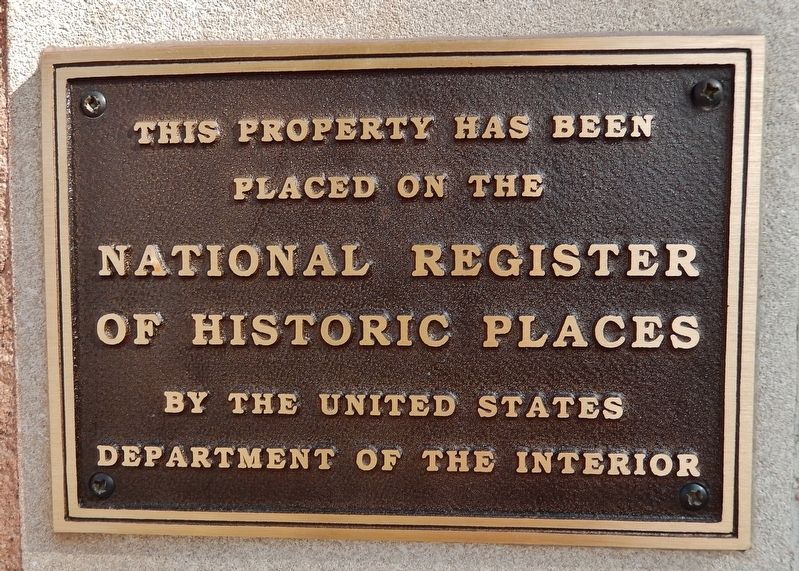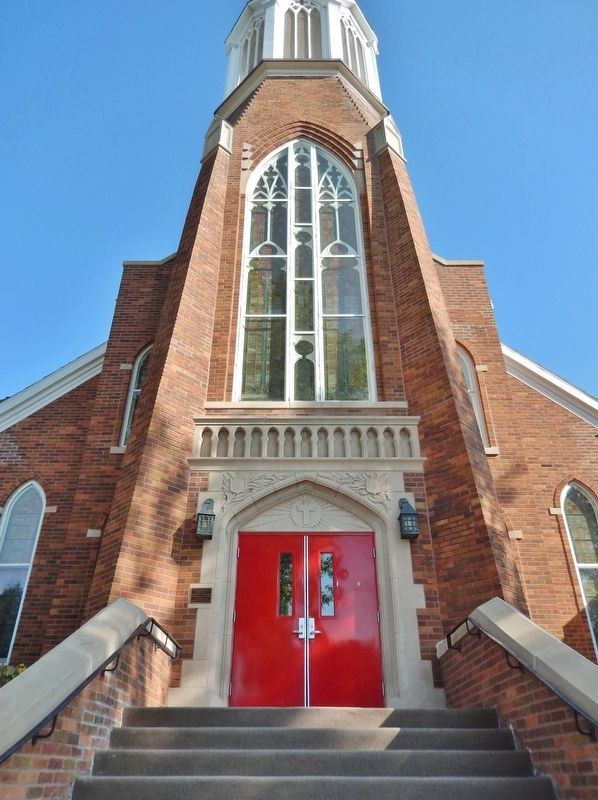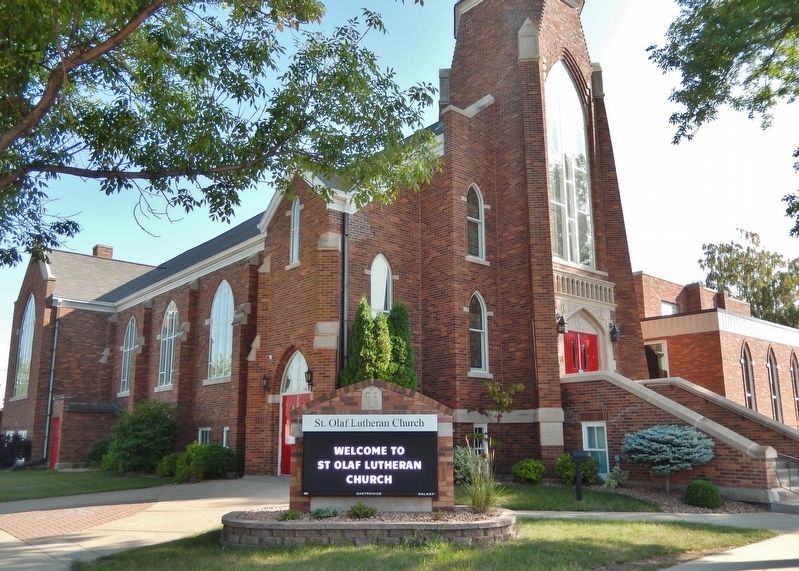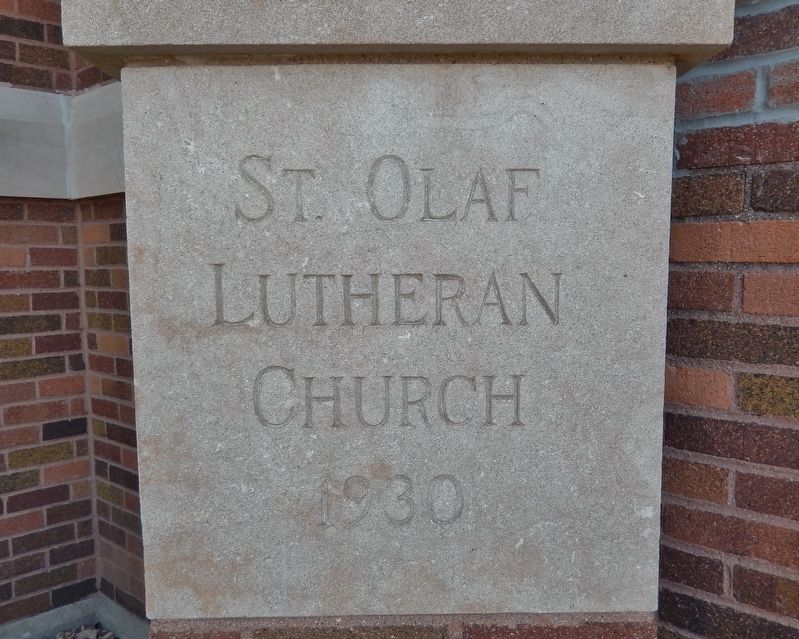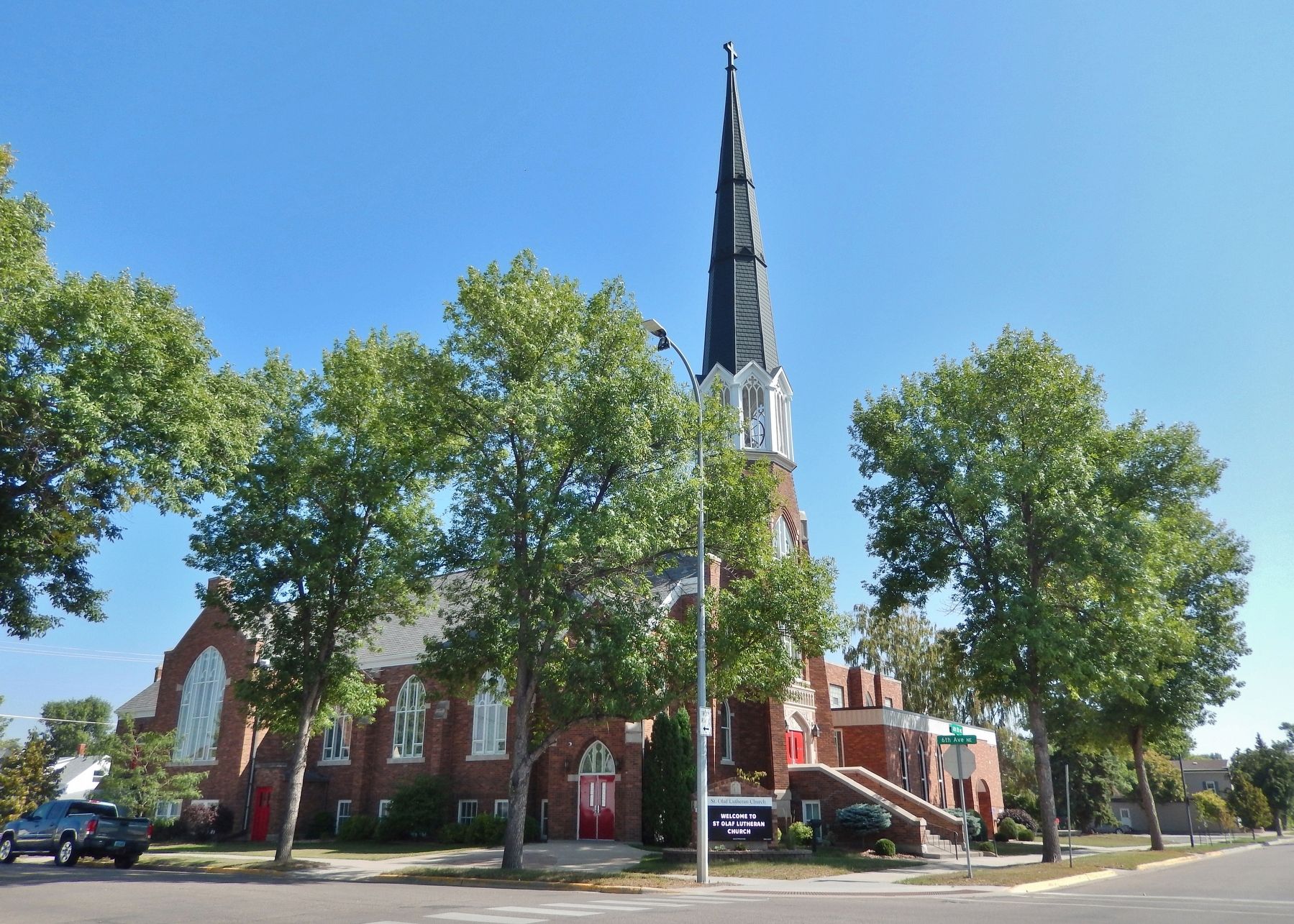St. Olaf Lutheran Church
placed on the
National Register
of Historic Places
by the United States
Department of the Interior
Topics and series. This historical marker is listed in these topic lists: Architecture • Churches & Religion • Notable Buildings • Settlements & Settlers. In addition, it is included in the National Register of Historic Places series list. A significant historical year for this entry is 1930.
Location. 48° 6.837′ N, 98° 51.419′ W. Marker is in Devils Lake, North Dakota, in Ramsey County. Marker is at the intersection of 6th Street Northeast and 6th Avenue Northeast, on the right when traveling west on 6th Street Northeast. The marker is mounted at eye-level, directly on the subject building, on the left side of the south/front entrance. Touch for map. Marker is at or near this postal address: 601 6th Street Northeast, Devils Lake ND 58301, United States of America. Touch for directions.
Other nearby markers. At least 8 other markers are within walking distance of this marker. Newport Apartments (about 400 feet away, measured in a direct line); Methodist Episcopal Church (about 400 feet away); Episcopal Church of the Advent and Guild Hall (about 400 feet away); Westminster Presbyterian Church (about 500 feet away); Sheriff's Residence (about 600 feet away); Devils Lake Masonic Temple (about 700 feet away); The Gilbertson (about 800 feet away); World War Memorial Building (approx. 0.2 miles away). Touch for a list and map of all markers in Devils Lake.
Regarding St. Olaf Lutheran Church. National Register of Historic Places #15000106.
From the National Register Nomination:
The St. Olaf Lutheran Church was built in 1930. It is located at the same intersection just diagonally across the street from where the original church was located. The older congregational wood-frame building was built in 1888. The 1888 church does not exist anymore. The existing church as it stands now consists of the original building of 1930, a class room addition built in 1954, and a more recent Centennial Room Addition built in 1987.St. Olaf Lutheran Church was designed by architect Joseph A. Shannon (1857-1934). Mr. Shannon was Devils Lake's first bona fide architect. The traditional design of the Late Gothic Revival St. Olaf Church symbolizes the doctrinal conservatism of the Norwegian Lutheran church and the cultural conservatism of the local Norwegian American community. St. Olaf Church shows Mr. Shannon was
adept at adopting the Late Gothic Revival style, emphasizing verticality with a steeply-pitched roof, tall bell-tower topped with a soaring spire, pointed arched windows and entrance, and a vaulted ceiling. His design also included Late Gothic Revival characteristic elements such as, the dark brick exterior with decorative light limestone decorative banding, use of ornate limestone door jambs, and two-tiered masonry buttresses with limestone trim.St. Olaf Lutheran Church was historically associated with the ethnic Norwegian-Lutheran commercial, agricultural, and religious community in the Devils Lake area, within a historical context of the insularity and nationalist identity of the local Norwegian-American community. The Church’s architecture is a reflection of this association. The Norwegian immigrants adhered to their Lutheran heritage and the St. Olaf congregation adhered to its Norwegian identity and the Norwegian language. Services were exclusively in Norwegian until 1898. Until 1920, one-half of the services were in Norwegian and one-half were in English. In 1921, the church was identified as "St. Olaf's Norwegian Lutheran Church." By 1933, however, all services were in English, with only the occasional special communion services in Norwegian.
Also see . . .
1. St. Olaf Lutheran Church (Wikipedia). Excerpt:
The St. Olaf Congregation was organized in 1885, and another congregation merged in 1887. A wood-frame church was built by 1888 at Sixth St. and Sixth Ave. in Devils Lake. In 1929 the lot diagonally across was purchased for a new, larger church, and despite the onset of the Great Depression the present church was built during 1930.(Submitted on February 17, 2024, by Cosmos Mariner of Cape Canaveral, Florida.)
2. St. Olaf Lutheran Church (Church website). Excerpt:
When Rev. O.H. Aaberg made his first missionary journey to Fort Totten in 1881, there was only one white family living north of Devils Lake. On a later journey in 1883, he found many Norwegian families in the Devils Lake area. In visiting with them, he became acutely aware of their yearning for a church of their own and promised to return to them the following summer to perform ministerial acts, such as baptisms, should there be need for them. The summer of 1884, he returned and conducted the first Lutheran service in Devils Lake on August 24, 1884. Services were again held September 7, November 23, and Christmas Day of that year, and on New Year’s Day, 1885. The following June, Rev. Aaberg moved to Devils Lake, and formally organized St. Olaf Congregation, July 20, 1885. A constitution was adopted, and Rev. Aaberg accepted the call to be their first pastor.(Submitted on February 17, 2024, by Cosmos Mariner of Cape Canaveral, Florida.)St. Olaf grew to the point that, in the 1920’s, it was apparent that the congregation had outgrown its present building. On April 21, 1929, land for this new church was purchased diagonally across the intersection from their present building. The stock market crashed later that same year and our country entered the Great Depression; yet it was decided to go ahead and build the beautiful new structure that had been planned. Groundbreaking was held on April 6, 1930, and the new church was dedicated on October 19, 1930. It was truly a step of faith to build such a church when the nation’s economy was in a shambles.
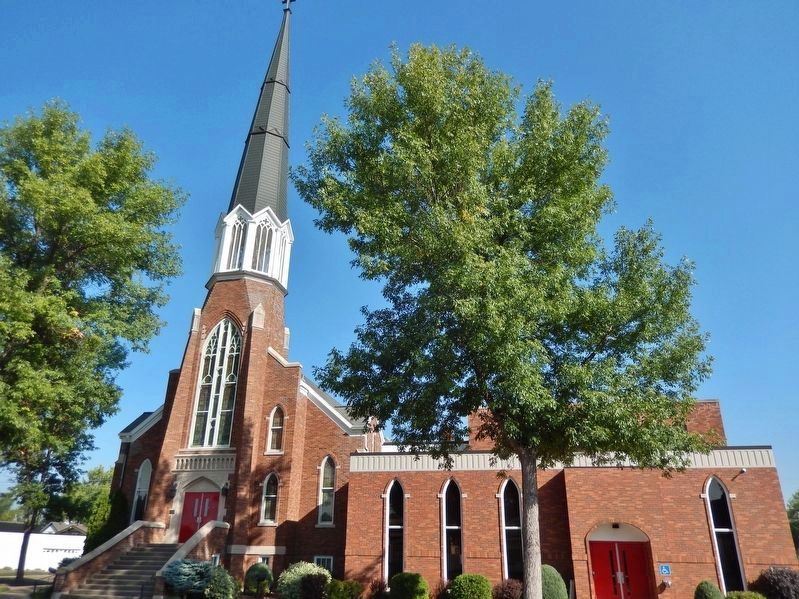
Credits. This page was last revised on February 17, 2024. It was originally submitted on February 16, 2024, by Cosmos Mariner of Cape Canaveral, Florida. This page has been viewed 54 times since then. Photos: 1, 2, 3, 4, 5, 6. submitted on February 17, 2024, by Cosmos Mariner of Cape Canaveral, Florida.
